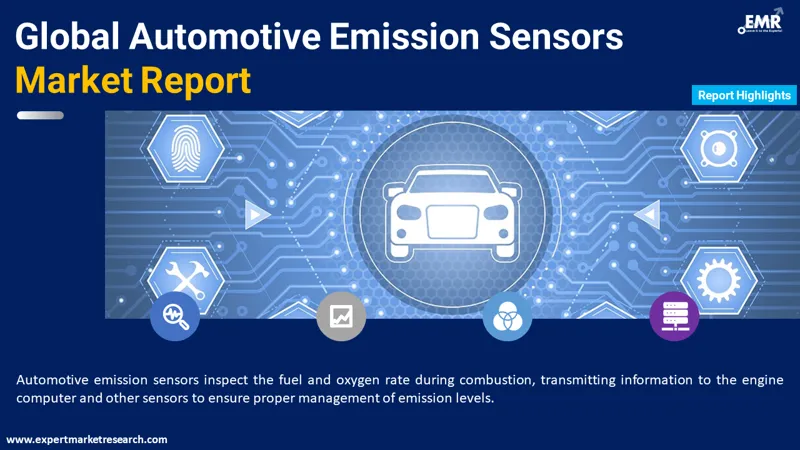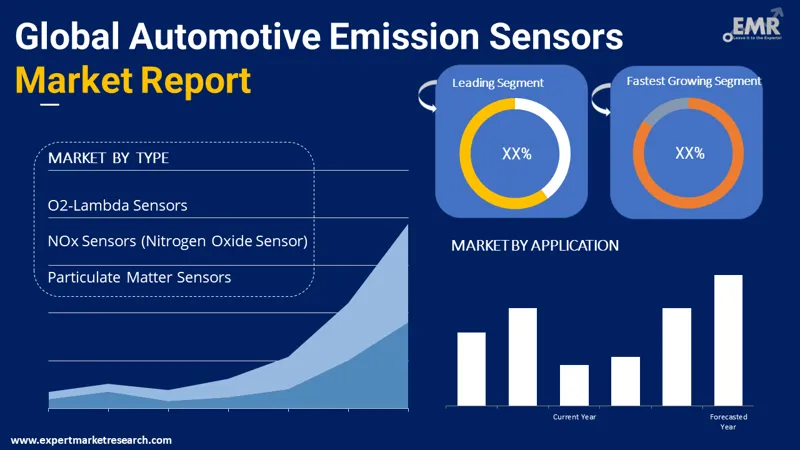
Consumer Insights
Uncover trends and behaviors shaping consumer choices today
Procurement Insights
Optimize your sourcing strategy with key market data
Industry Stats
Stay ahead with the latest trends and market analysis.
The global automotive emission sensors market will grow at a CAGR of about 14.20% in the forecast period of 2026-2035, driven by the global developing automobile industry.
Base Year
Historical Period
Forecast Period
Compound Annual Growth Rate
14.2%
2026-2035
*this image is indicative*
North America accounts for a significant share of the global automotive emission sensors market due to the presence of established players. The increased demand for the product in the region has also compelled the manufacturers to invest in research and development. The government is making strict policies to enforce the application of emission sensors in automobiles, which has been adding significantly to its market demand. The growing concern of air pollution and environmental hazards is a significant factor leading to a higher demand for emission sensors.

Read more about this report - REQUEST FREE SAMPLE COPY IN PDF
Asia Pacific is showing significant growth in the automotive emission sensors market. The main influencing factor for this growth is the large and rapidly growing population in countries such as China and India. The increase in population will come with an increased demand for passenger and commercial vehicles, leading to increased emissions. Governments are enacting strict rules to restrict emissions and improve public health to combat this, as it significantly contributes to air pollution and global warming. The policies help to develop the sector even more.

Read more about this report - REQUEST FREE SAMPLE COPY IN PDF
Automotive emission sensors are electronic devices that monitor the amount of oxygen in the exhaust and gas, provide the information to the engine computer, and handle the unburned oxygen levels from the vehicle. It is a critical component of making a car safer and fuel-efficient.
The types of automotive emission sensors in the market include the following:
The applications of automotive emission sensors can be divided into:
The regional automotive emission sensors market includes:
Governments worldwide are noticing the importance of emission control and have started implementing strict regulations. As the world's population grows, so will the number of automobiles on the road. Automobiles are essential to our everyday lives and must be fuel-efficient to prevent pollution. Manufacturers are using emission sensors as a smart option to control the emission levels of vehicles. These emission sensors can inspect the fuel and oxygen rate during combustion and relay the information to the engine computer and other sensors, so the levels are correctly managed. As a result, the vehicle's lifespan is also preserved, and the performance drop with regular use becomes minimal. This has been adding to the demand for emission sensors, leading to market growth.
With time, people are starting to lean toward more fuel-efficient options. To achieve all these goals, considerable research and developments are being carried out to build technologically superior emission sensors. This gives further impetus to the market growth.
The report gives a detailed analysis of the following key players in the global automotive emission sensors market, covering their competitive landscape, capacity, and latest developments like mergers, acquisitions, and investments, expansions of capacity, and plant turnarounds:
The EMR report is carefully curated to provide detailed industry insights on the market based on Porter's five forces model and SWOT analysis.




*While we strive to always give you current and accurate information, the numbers depicted on the website are indicative and may differ from the actual numbers in the main report. At Expert Market Research, we aim to bring you the latest insights and trends in the market. Using our analyses and forecasts, stakeholders can understand the market dynamics, navigate challenges, and capitalize on opportunities to make data-driven strategic decisions.*
Get in touch with us for a customized solution tailored to your unique requirements and save upto 35%!
The market is expected to grow at a CAGR of 14.20% in the forecast period of 2026-2035.
The primary drivers for emission sensors include the thriving population and the consequent increase in the demand for automobiles, rising research and development by manufacturers for better technology, and government policies to ensure proper standards.
The rising demand for reducing carbon emissions to meet the standards of government policies is an ongoing trend in the industry.
The major regional markets can be divided into North America, Latin America, the Middle East, Africa, Europe, and the Asia Pacific, with North America being an established market region and the Asia Pacific being the fastest-growing market.
The types of emission sensors in the market include O2-Lambda Sensors, NOx Sensors, and particulate matter sensors.
The product finds application in passenger cars and commercial vehicles. Passenger cars are the predominant application sector for the industry.
The key industry players include Continental AG, Denso Corporation, Delphi Automotive PLC, Robert Bosch Gmb, and Coorstek Inc, among others.
Explore our key highlights of the report and gain a concise overview of key findings, trends, and actionable insights that will empower your strategic decisions.
| REPORT FEATURES | DETAILS |
| Base Year | 2025 |
| Historical Period | 2019-2025 |
| Forecast Period | 2026-2035 |
| Scope of the Report |
Historical and Forecast Trends, Industry Drivers and Constraints, Historical and Forecast Market Analysis by Segment:
|
| Breakup by Type |
|
| Breakup by Application |
|
| Breakup by Region |
|
| Market Dynamics |
|
| Competitive Landscape |
|
| Companies Covered |
|
| Report Price and Purchase Option | Explore our purchase options that are best suited to your resources and industry needs. |
| Delivery Format | Delivered as an attached PDF and Excel through email, with an option of receiving an editable PPT, according to the purchase option. |
Datasheet
One User
USD 2,499
USD 2,249
tax inclusive*
Single User License
One User
USD 3,999
USD 3,599
tax inclusive*
Five User License
Five User
USD 4,999
USD 4,249
tax inclusive*
Corporate License
Unlimited Users
USD 5,999
USD 5,099
tax inclusive*
*Please note that the prices mentioned below are starting prices for each bundle type. Kindly contact our team for further details.*
Flash Bundle
Small Business Bundle
Growth Bundle
Enterprise Bundle
*Please note that the prices mentioned below are starting prices for each bundle type. Kindly contact our team for further details.*
Flash Bundle
Number of Reports: 3
20%
tax inclusive*
Small Business Bundle
Number of Reports: 5
25%
tax inclusive*
Growth Bundle
Number of Reports: 8
30%
tax inclusive*
Enterprise Bundle
Number of Reports: 10
35%
tax inclusive*
How To Order

Select License Type
Choose the right license for your needs and access rights.

Click on ‘Buy Now’
Add the report to your cart with one click and proceed to register.

Select Mode of Payment
Choose a payment option for a secure checkout. You will be redirected accordingly.
Gain insights to stay ahead and seize opportunities.

Get insights & trends for a competitive edge.

Track prices with detailed trend reports.

Analyse trade data for supply chain insights.

Leverage cost reports for smart savings

Enhance supply chain with partnerships.

Connect For More Information
Our expert team of analysts will offer full support and resolve any queries regarding the report, before and after the purchase.
Our expert team of analysts will offer full support and resolve any queries regarding the report, before and after the purchase.
We employ meticulous research methods, blending advanced analytics and expert insights to deliver accurate, actionable industry intelligence, staying ahead of competitors.
Our skilled analysts offer unparalleled competitive advantage with detailed insights on current and emerging markets, ensuring your strategic edge.
We offer an in-depth yet simplified presentation of industry insights and analysis to meet your specific requirements effectively.
Share